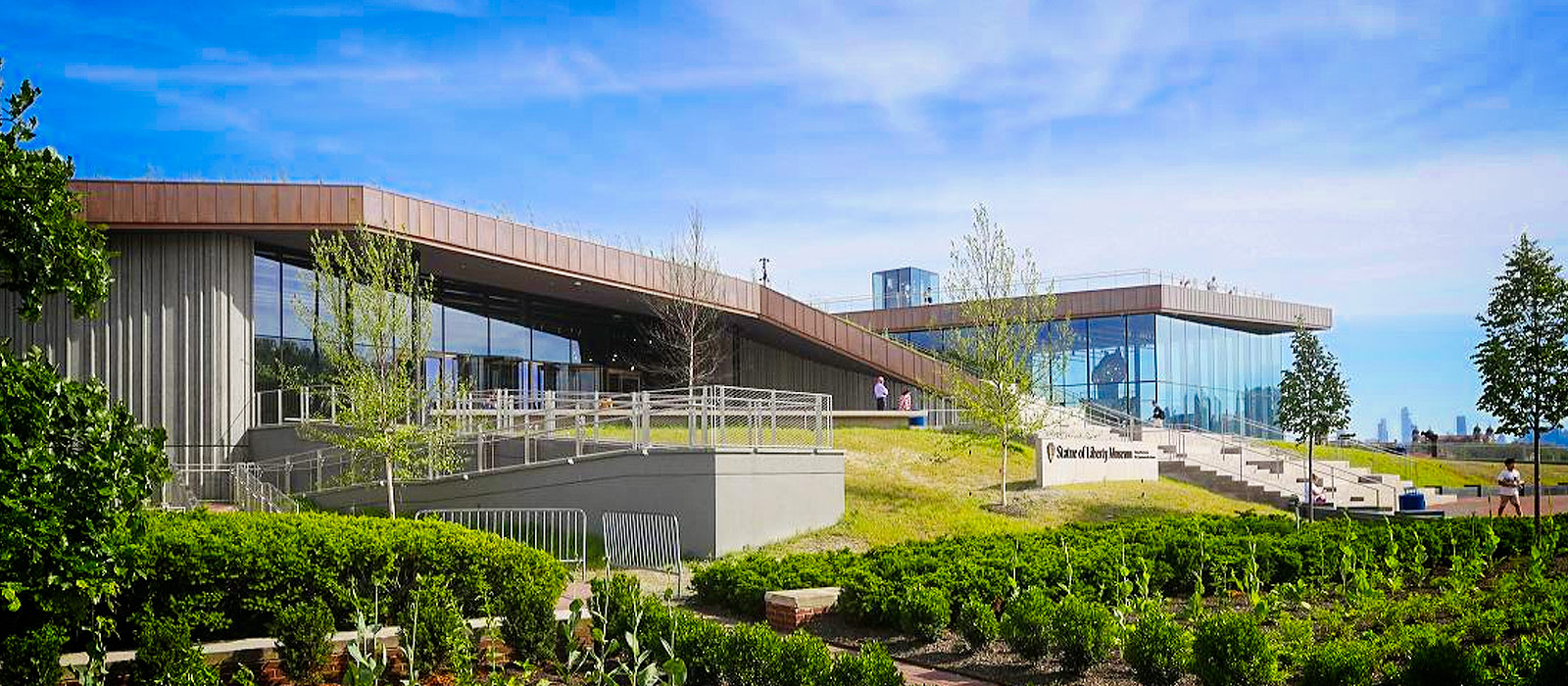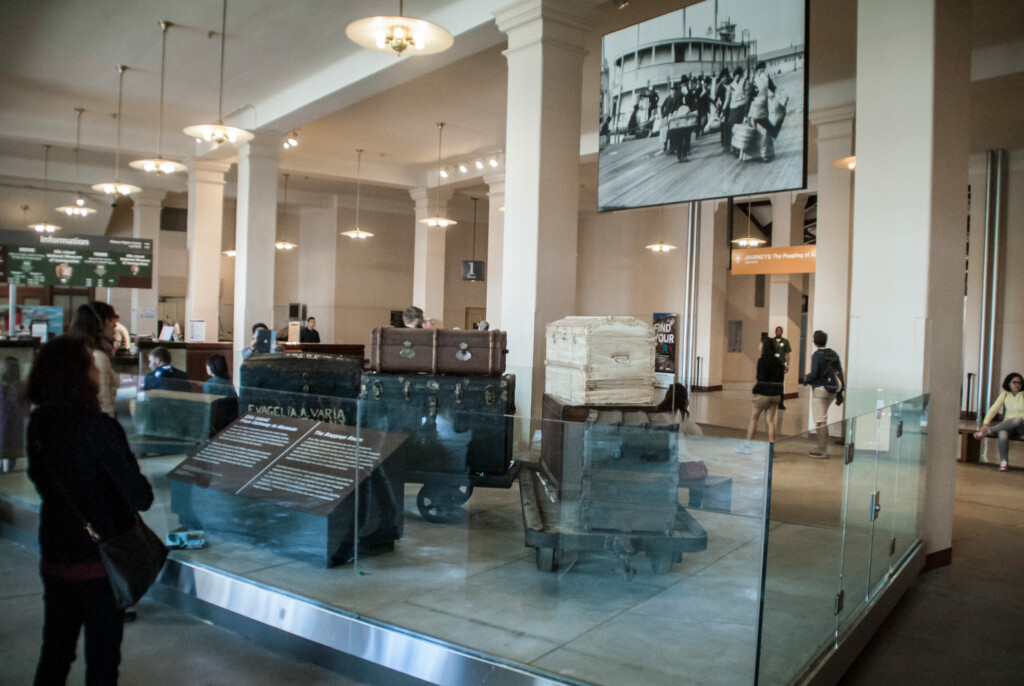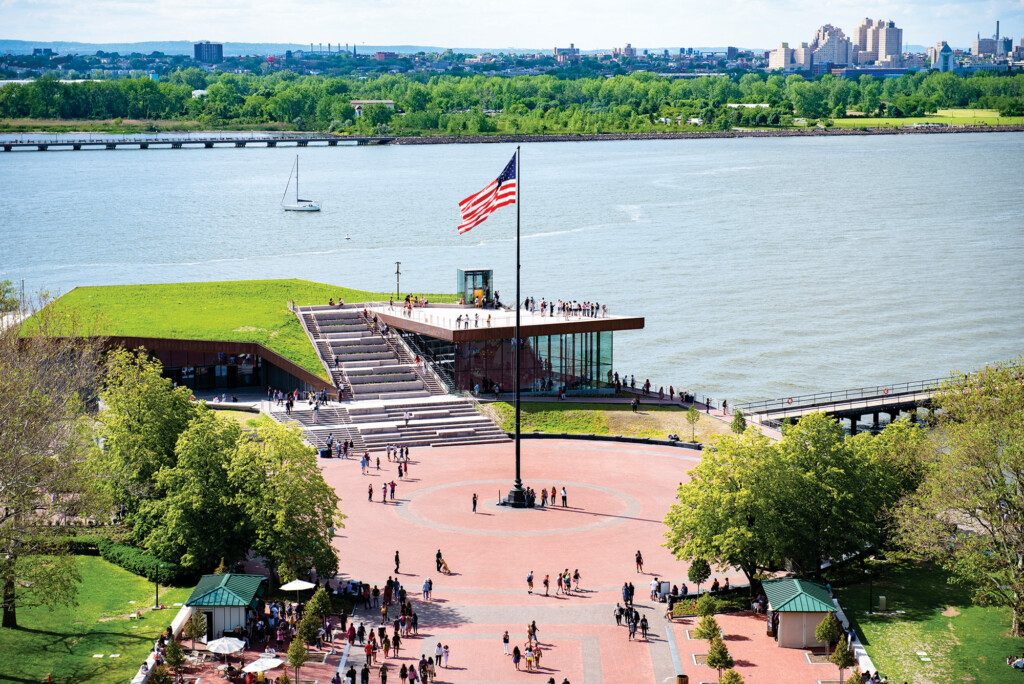ESF Alumnus Carries a Torch for Historic Preservation
By Karen B. Moore
The Statue of Liberty is an American icon, symbolizing hope and freedom to millions who come to America and those who have been here for generations. ESF alumnus Jeffrey Rainforth ’97 (CM) is playing a major role in its preservation and that of the surrounding environment, and it’s not something he takes lightly.
“There’s no other feeling like it as you’re coming in on the ferry in the morning and the fog’s coming across the Hudson and there’s the statue in the background,” said Rainforth, whose company recently completed construction of the new Statue of Liberty Museum on Liberty Island.
There were times when he and his crew were on the island in New York Harbor until 2 or 3 a.m. as the work dictated. “It was just us and the statue,” he said. “You would stand there and look up at it and you can’t believe you’re there by yourself in the middle of the Hudson River looking up at the statue. It’s pretty special.”
Rainforth is vice president of the Phelps Construction Group based in Boonton, New Jersey, and project executive on the company’s Liberty and Ellis islands projects. He has been instrumental in ensuring that not only will the Statue of Liberty be here for future generations, but that the surrounding grounds and museums provide visitors with an immersive experience.
Rainforth and his partner Douglas Phelps formed Phelps Construction in 2007 after working together for another construction company. At that company they worked on the restoration of the Statue of Liberty following the events of 9/11 as officials realized the statue was a potential target for terrorist attacks.
“At that point the only way up was a spiral staircase and the only way down was a spiral staircase,” said Rainforth. “There was no emergency evacuation; there was only one way in or out, so they figured that was not a good situation.” Life safety upgrades included adding a sprinkler system throughout the statue and egress stairs. Stairs that went to the statue’s crown were removed and blast-resistant glass was installed, preventing visitors from climbing into the statue’s crown.
“You could stand at the last pedestal level and look up into the statue and hear a story through a new AV system,” Rainforth said. “But about three years later some politicians didn’t like the idea that they took away the ability of people to go into the crown and they ended up putting in elevators to take you up to the crown. But the number of people who can visit the crown is now limited to approximately 400 per day.”
Phelps Construction is no stranger to work on Liberty and Ellis islands, which together make up the Statue of Liberty National Monument. The company completed work on the Peopling of America Center on Ellis Island in 2015. That project involved a large museum restoration and creation of new museum space in the existing historic buildings. The new museum areas tell the story of immigration to the United States in the post-Ellis Island era. Ellis Island was then renamed The National Museum of Immigration.
“We went right from the Peopling of America project to planning for the Statue of Liberty Museum in 2015,” Rainforth said. It took about a year and half of planning and working with architects to develop the designs and proper budgets before the groundbreaking in late 2016.
The work on Liberty and Ellis islands is funded through the nonprofit Statue of Liberty Ellis Island Foundation (SOLEIF). The money is privately raised and, through a partnership between the SOLEIF and the National Park Service, is donated to the park service to be used on various projects.
The use of native plantings was just a part of the use of best practices for sustainability.
The Statue of Liberty Museum was one such project. The 26-month project resulted in construction of a 26,000-square-foot building that provides the estimated 4.3 million annual visitors the opportunity to learn about the Statue of Liberty’s history, influence and legacy through three gallery spaces and artifacts, including the statue’s original torch.
During that time, the company also built a new secure screening facility to replace the not-so-temporary facility that was installed in a tent during the 2003 restoration of the statue. “At that point (in 2003) there was limited security,” Rainforth said. “The events of 9/11 changed the manner in which people could access the statue. The tent housed modern airport-type security systems.”
With work being done on the Statue of Liberty Museum it was decided to replace the tent with a permanent structure. “We built another environmentally sensitive structure called the Secured Screening Facility that was a mass timber structure with a green roof alongside the Statue of Liberty to house the screening equipment. This building was designed and built in 10 months so as not to impact the opening of the new museum.
“At that point, the NPS and SOLIEF figured they’ve been under construction since (Superstorm) Sandy so they decided to do an island-wide beautification project where we did much of the landscape and hardscape over.” The island beautification project used native plants and grasses that were on the island 150 years ago, around the time of the statue’s construction. “We removed and replaced landscaping and pavers and created pathways to enhance the visitor’s experience on the island,” he said.
The use of native plantings was just a part of the use of best practices for sustainability. The Statue of Liberty Museum was built to withstand hurricane-force winds, and includes a green roofscape and bird-safe glass exteriors to protect against extreme weather events such as 2012’s Superstorm Sandy. That storm devastated the island, caused approximately $70 billion in damages and killed more than 200 people in the Caribbean and the United States. The new museum was designed to be 11 feet above the 500-year flood levels.
Completion of the museum was celebrated May 16 at a star-studded event on Liberty Island with celebrities such as Oprah Winfrey, David Letterman, Hillary and Chelsea Clinton, Jeff Bezos and fashion designer Diane von Furstenberg in attendance. Von Furstenberg is considered the “godmother of the Liberty Island Project” because of her major fundraising efforts that made the project possible.
“It was just great to see all these famous people who made major donations to the project,” Rainforth said. “It was more special for Doug and I to spend a night celebrating with our employees and the project team who worked so hard to build the museum and restore the island.” The next day the museum was open to the public, which was also a memorable event. “It was great because the event was open to the public. Anyone who was on the island that day was a part of the televised event and had access to the new museum.”
Phelps Construction Group’s work on nearby Ellis Island, which served as an immigration station for more than 12 million immigrants until it closed in 1954, continues today. The project involves historic restoration of an outdoor recreation structure on the island’s south side. “This is the part of the island that hasn’t really been restored at all,” said Rainforth.
Rainforth credits his time at ESF for giving him an introduction to green technologies. “When I started in the industry in 1995, it was something that was just taking off,” he said.
After transferring to ESF from SUNY Delhi, where he earned an associate’s degree in carpentry, Rainforth gained an interest in green technologies at ESF. “When I was at ESF green technologies were just starting. There wasn’t a course designed for it, but I know since then it’s really the basis of some of the programs there.”
Rainforth credits Ken Tiss ’78, then an instructor in the construction management program, with inspiring him on his career path. “He was an industry professional and professor who would spend extra hours with us and help guide us in the right direction down our career paths. He was always very helpful going the extra mile and helping us with the real-life experience that he had coming from the industry. While he taught the lessons from our textbooks, he also taught us the lessons he learned being in industry himself. These are the lessons that taught me the most.”
Phelps Construction Group continues work on other projects but maintains ties to some special islands in New York Harbor.
“We’re always on Liberty and Ellis Island doing something,” Rainforth said.
Karen B. Moore is the senior writer in the Office of Communications and Marketing. Karen B. Moore is editor of ESF Magazine.





